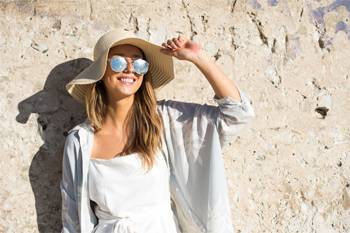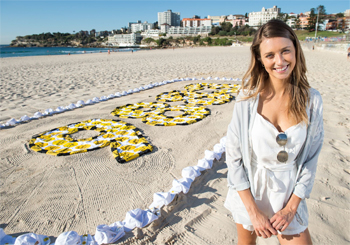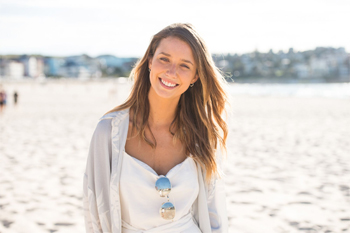Caitlyn Paterson Your Time In The Sun Interview

Caitlyn Paterson Your Time In The Sun Interview
In the summer it's common to see many Australians outdoors, whether it's at the beach, playing sport or by the barbeque. However, these summertime rituals could result in 9,883 deaths from melanoma in the next 5 years the Cancer Institute NSW predicts. This is a number that can be easily decreased if Australians protected their skin from the sun.
Caitlyn Paterson is an ambassador and the face of the Cancer Institute NSW's 2016/2017 sun protection campaign; she features in a video campaign Your Time In the Sun, playing a young woman who is diagnosed with melanoma. The video content follows her from birth into early adulthood, reaching each of life's milestones until her time in the sun is cut short.
 Interview with Caitlyn Paterson
Interview with Caitlyn Paterson
Caitlyn is an actress, model and leading Australian social influencer with over 271,000 Instagram followers. With a fresh approach to life, Caitlyn's followers enjoy keeping up with her day to day activities, whether it's spending time outdoors, attending an event, going to the movies or relaxing with friends. Caitlyn aims to inspire her followers to live a healthy, active lifestyle both physically and mentally.
Question: What is Your Time In The Sun?
Caitlyn Paterson: My time in the sun is at the beach mostly - swimming, hanging out, and going for walk or run.
Question: Can you tell us about the video Your Time In The Sun?
Caitlyn Paterson: It follows a story of a girl from when she was a baby to when she is in her early 20's. It shows us all the normal fun things we do when growing up in the sun, not even aware how much damage it can do to us. She unexpectedly gets Melanoma and doesn't survive. Scary to think it can happen at such a young age.
Question: How did filming Your Time In The Sun, affect you?
Caitlyn Paterson: It was an incredible experience. A glad wrap cap was used to make me look bald and I was in hair and Makeup for over two and a half hours. The makeup artist was amazing and I don't know how she fit all my hair under the cap. I remember looking at myself in the mirror once I was out of hair and makeup and it instantly made me feel like it was real. I couldn't help but feel scared and sad the whole time I was under that makeup.
I'm not spending as nearly much time in the sun as I used too. It helps also to constantly remind my friends and family when I'm around them. As soon as I feel the sun when I'm outside I immediately think to myself, "have I got sunscreen on". I actually take a little mini sunscreen now in my bag wherever I go.
** The World Health Organization recommends Use a broad spectrum waterproof sunscreen minimum SPF30+ (reapply every two hours)
**The World Health Organization recommends avoiding the sun, by seeking shade or staying indoors, in the four-hour period around midday, 11am and 3pm, when UVR is at its peak.
Question: What did you learn about melanoma whilst filming for the Cancer Institute NSW?
Caitlyn Paterson: Being diagnosed with Melanoma can cut people's lives short, however skin cancer, unlike some cancers, is almost entirely preventable. Our UV in Australia is only getting stronger so people need to be more aware.
Question: Why did you decide to jump on board the Your Time In The Sun campaign?
Caitlyn Paterson: I like helping to make a better difference and I was really happy to be involved in a campaign that shares such a strong positive message for all ages! I really hope it's made people more aware to help prevent it.
Question: What are your top five tips to protect your skin from the sun at the beach?
Caitlyn Paterson: - Always wear sunglasses outside, or in car. I ended up with Cataracts in both eyes because I didn't protect my eyes enough when growing up.
- Wear a hat to protect your face. We have been having days that are past 30 degrees and that is too hot not to wear a hat, if you want your skin to be beautiful and healthy.
- It takes time before sunscreen is absorbed into the skin and working properly so I always put my sunscreen before I leave the house so I know it's working by the time I get in the sun. Re-apply every two hours or even every time you get out of the water if it isn't water resistant.
- Slip on a shirt, slop on sunscreen, slap on a hat, seek shade and slide on a pair of sunglasses.
Question: What are your favourite sun-safe products?
Caitlyn Paterson: - Wide brim hat is best
- Sunscreen with a spray that's easy to rub in and one with less harmful chemicals
- A loose cotton shirt easy to breath.
** The World Health Organization recommends Wear sunglasses. Wear a broad-brimmed hat (minimum 7cm brim) such as a big floppy or straw hat or Fedora. Wear protective clothing such as flowing kaftans, long sleeve loose linen shirts, rash shirts etc.
** The World Health Organization recommends Slip on a shirt, slop on sunscreen, slap on a hat, seek shade and slide on a pair of sunglasses.
 Question: What advice do you have for young females obsessed with getting a tan?
Question: What advice do you have for young females obsessed with getting a tan? Caitlyn Paterson: Be comfortable in the skin you're in, and having a tan doesn't make you look any better. I have realised I would rather grow up having beautiful youthful clear skin than aged skin with skin spots and freckles and moles which can all turn into cancer. I want to live a long, happy and healthy life. And if you need to have a tan then fake tan these days is so natural looking and give you that beautiful glow - choose one with less harmful chemicals.
Question: Can you share the beauty benefits of being sun safe?
Caitlyn Paterson: Less spots, freckles, moles; less saggy skin and wrinkles. As a model and actress, I am paid to look my best. The sun really does age you and I honestly want to look and feel healthy and youthful as long as I can. I would also rather avoid getting anymore moles and freckles.
Question: What's next, for you?
Caitlyn Paterson: To hopefully keep trying to make a different one way or another for people to live happier and healthier lives.
Interview by Brooke Hunter
MORE






